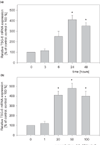Gene expression induced by interleukin-17 in fibroblast-like synoviocytes of patients with rheumatoid arthritis: upregulation of hyaluronan-binding protein TSG-6
- PMID: 12823853
- PMCID: PMC165059
- DOI: 10.1186/ar762
Gene expression induced by interleukin-17 in fibroblast-like synoviocytes of patients with rheumatoid arthritis: upregulation of hyaluronan-binding protein TSG-6
Abstract
Interleukin-17 (IL-17) has been characterized as a proinflammatory cytokine produced by CD4+ CD45RO+ memory T cells. Overproduction of IL-17 was detected in the synovium of patients with rheumatoid arthritis (RA) compared with patients with osteoarthritis. This study examines differentially expressed genes after the stimulation of fibroblast-like synoviocytes of RA patients by IL-17. Among these genes we identified the following: tumor necrosis factor-stimulated gene-6 (TSG-6), IL-6, IL-8, GRO-beta, and bone morphogenetic protein-6 with an expression 3.6-10.6-fold that in the unstimulated control. IL-17 augmented the expression of TSG-6, a hyaluronan-binding protein, in a time- and dose-dependent manner. IL-17 showed additive effects with IL-1beta and tumour necrosis factor-alpha on the expression of TSG-6, IL-6 and IL-8. The mitogen-activated protein kinase p38 seems to be necessary for the regulation of TSG-6 expression by IL-17, as shown by inhibition with SB203580. Our results support the hypothesis that IL-17 is important in the pathogenesis of RA, contributing to an unbalanced production of cytokines as well as participating in connective tissue remodeling.
Figures






References
-
- Firestein GS. Invasive fibroblast-like synoviocytes in rheumatoid arthritis. Passive responders or transformed aggressors? Arthritis Rheum. 1996;39:1781–1790. - PubMed
-
- Breedveld FC. New insights in the pathogenesis of rheumatoid arthritis. J Rheumatol. 1998;53(suppl):S3–S7. - PubMed
-
- Feldmann M, Brennan FM, Maini RN. Rheumatoid arthritis. Cell. 1996;85:307–310. - PubMed
MeSH terms
Substances
LinkOut - more resources
Full Text Sources
Medical
Research Materials
Miscellaneous

